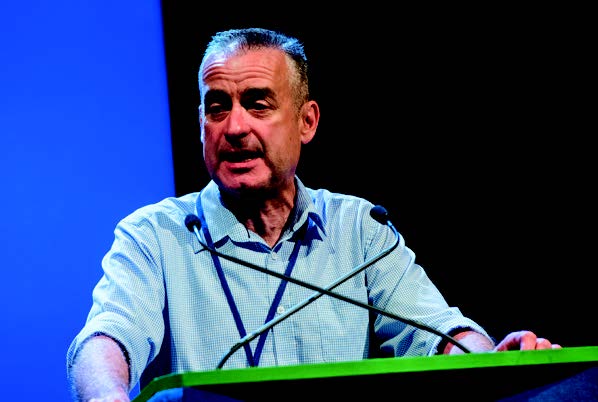January’s meeting of EIS Council took place shortly before the consultative ballot on the pay offer from COSLA and the Scottish Government was due to close. A few days after Council had met, the ballot closed and the result (98% voting for rejection of the offer, on a turnout of 53%) was confirmed.
Although the ballot was still ongoing at the time of the meeting, the debate at Council centred around what should happen following the ballot, on the assumption that a strong rejection would, indeed, be the end result.

Salaries Convener Des Morris outlined the long and arduous negotiation process that had taken place prior to the decision to ballot members. Mr Morris told Council that, following the ballot, the Salaries Committee would meet to consider the result, and to plan the next steps. The Committee would agree, also, the pay claim for 2022-2023 to be submitted via the Scottish Negotiating Committee for Teachers (SNCT).
“Teachers are currently the only group of public sector workers without a pay settlement for 2021,” said Mr Morris. He added that, given that local authority budgets for last year are already effectively spent, “It is clear that any additional money to enhance the pay settlement will need to come from the Scottish Government – there will be no more money coming onto the table from COSLA.”
In addition to the many delays in negotiations resulting from, among other things, the Covid pandemic, delays in budget-setting at UK, Scottish and council levels, last year’s Scottish Parliament elections and, also, continuing procrastination by COSLA and the Scottish Government, Mr Morris also highlighted another significant barrier: COSLA’s “one workforce” agenda, where they argue that all their employees should receive the same percentage pay rise. With other bargaining groups having already settled for offers poorer than the one the EIS was balloting on, this made progress in negotiations extremely challenging.
Mr Morris added that, following the anticipated rejection of the offer in the ballot, there was an expectation that a revised offer would be tabled at a planned negotiating meeting on the 10th of February (after this edition of the SEJ went to press).
The Convener highlighted that a key consideration for the Salaries Committee was that the local government elections coming up in May will mean a period of purdah beforehand, and a period of reorganisation afterwards, which could mean we would be at almost 20 months without a pay settlement if no agreement is reached before the purdah period inevitably halts negotiations.
Mr Morris said that it would be a strategic question for the Salaries Committee as to whether we then seek to settle this year’s claim, and use local elections as a springboard to launch a campaign for a far more substantial settlement for the year 2022-2023.
Nicola Fisher (Glasgow) asked, “Given that COSLA seems determined to cling to the one workforce agenda which seeks to suppress teacher pay in order not to upset other workers, should a priority of the EIS be to continue to challenge the one workforce agenda and to demand that COSLA respect our SNCT has part of the bargaining process?”
Mr Morris agreed, highlighting that a resolution from the EIS AGM had reaffirmed our position on the independence and importance of the SNCT. This would, he added, also be a key point in the EIS Local Government Manifesto and campaigning ahead of the local authority elections.
Steve Rance (East Dunbartonshire) asked, “Is there any correlation between our current pay claim and the possibility that the Scottish Government have got one eye on the finances to fund the 3000 teachers who we need? Should we be cognisant of that in respect of our pay claim?”
Mr Morris replied, “I’m sure the Scottish Government would like to see a correlation, but we do not recognise it. The additional teachers were a political commitment from the Scottish Government – and it would be unacceptable if we had to effectively fund it ourselves through a lesser pay rise.”
Executive Committee
Vice-President Andrene Bamford told Council of the formation of a digital review group to look at all current and future digital working within the institute. Ms Bamford also advised Council that planning was underway for a return to in-person Committee and Council meetings, and an in-person Annual General Meeting in June.
Education
Susan Quinn, Convener, said that Education recovery and Covid continue to be the focus for Education Committee. The EIS was continuing to challenge national stakeholders to ensure that recovery means recovery and not just a return to business as usual, she said. On qualifications, Ms Quinn said that statements from the SQA confirm that there is an expectation that exams will go ahead this session.
Employment Relations
Convener David Baxter told Council that the Committee had considered a paper on misuse of TikTok, following a recent spate of incidents of pupils filming teachers without consent and posting these online. This should be reported to employers who must take it seriously, and police involvement is also possible, said Mr Baxter. He added that reporting issues to TikTok itself can also be effective, as they have often proven to be quick to take action in this type of case.
Equality
Convener Nicola Fisher reported to Council that work is ongoing to encourage members who are part of BAME, LGBT, or Disabled networks to consider running for Council and other committees. The Committee received a report on the status of EIS refugee welcome packs. Plans are in place for translating the packs into more languages, she said. Ms Fisher also said the refresh of the Face up to Child Poverty campaign is ongoing, with a focus on child hunger.
Motions
Motions calling on the EIS to offer support to the Stand up to Racism trade union conference (Mover: Donny Gluckstein) and to explore how to better support people with long Covid (Mover: Alison Murphy) were approved by Council.
